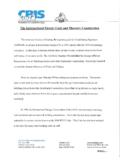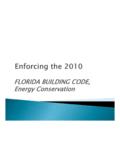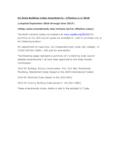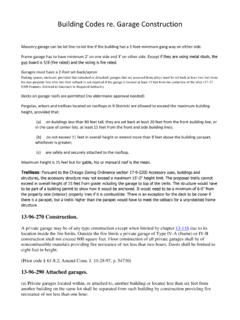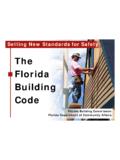Transcription of Residential Energy Codes in Great Lakes - michigan.gov
1 Residential Energy Codes in the Great Lakes Region Current Status of Residential Energy Codes in the Great Lakes Region Residential Energy Codes are mandatory statewide in most states in the Great Lakes region. The exception is Illinois. There is no statewide building code in Illinois, but municipalities may adopt an Energy code . It is estimated that one quarter of Illinois municipalities have adopted an Energy code . Some of them, including the City of Chicago, have adopted the 2000 International Energy Conservation code (IECC). Enforcement of the Chicago Energy Conservation code has been postponed until September 3, 2002 due to fiscal constraints. Pennsylvania has the oldest code in the region, the ASHRAE 90A-80 and 90B-75. In November 1999, Pennsylvania enacted a Uniform Construction code Act establishing a mandatory statewide building code for the first time.
2 That law mentions the adoption of the BOCA National Building code /1999 and requires the adoption of successor Codes no later than December 31 in the year in which they are issued. The BOCA National Building code /1999 was succeeded by the International Building code in January 2000. Pennsylvania is catching up and expects to adopt the 2000 IECC by December 2002. The standards would go into effect 90 days after they are adopted. Indiana presently has the 1992 Model Energy code (MEC). Indiana announced its intention to revise the Indiana Energy Conservation code on March 1 2002 in the Indiana Register. According to the Building code Assistance Project of the United States Department of Energy , the Indiana Department of Commerce has received a grant to study adoption of the 2000 IECC in Indiana. The Minnesota state Energy code is based on the 95 MEC.
3 However, the Minnesota code has elements, such as air leakage sealing and ventilation, that go well beyond the requirements of the 95 MEC. The Minnesota Department of Administration, Building Codes & Standards Division will be putting together a task force to consider the adoption of the 2000 IECC. Ohio and Wisconsin have Codes based on the 1995 MEC. New York adopted the 2000 IECC with amendments in May 2002. 2000 IECC Considering 2000 IECC 1995 Model Energy code City of Chicago New York Pennsylvania (ASHRAE 90A-80 & 90B-75) Indiana (92 MEC) Minnesota (95 MEC) Ohio Wisconsin Comparison of michigan Uniform Energy code to Energy Codes in the Region michigan developed its own Energy code following Department of Labor adoption of the Model Energy code and subsequent repeal of the rules by the Legislature. In 1996 a committee consisting of homebuilders, code officials, and other interested parties began 1drafting the michigan Uniform Energy code .
4 The Department of Consumer and Industry Services promulgated the code in 1999. Even the states that have adopted one of the model Codes have personalized their Codes in various ways. For example, New York made an adjustment to the IECC foundation insulation requirements to meet a payback (10 year simple payback) statute. The R-values remained the same, but depth of insulation was modified for degree-day zones, varying from 24 below grade to full height. Wisconsin has different requirements for non-electrically heated homes and electrically heated homes. For example, the ceiling insulation requirement for non-electrically heated homes is and the requirement for electrically heated homes is R-50. Minnesota has a two-tier code a mandatory standard that is based on the 1995 Model Energy code and a voluntary standard that is equivalent to a Five Star or Energy STAR level of efficiency.
5 Minnesota also has a unique provision in their law that mandates the Department of Public Service to adopt Energy code rules that equal or exceed the most Energy -conserving Codes adopted by any other state . Compliance with the national model Energy Codes or the MUEC can be determined in one of three ways: On a prescriptive basis where the minimum values or criteria for building components are specified, On a whole-house performance or systems analysis basis, where total building use for the proposed building may be no greater than the Energy budget of a "standard" building that meets code , and On a component performance basis where the thermal performance of the building envelope and other criteria are specified. 2 It is difficult to make direct comparisons between the different Energy Codes because the Codes are structured differently.
6 The following chart is intended to generally illustrate the differences between the 2000 IECC adopted by New York State and the MUEC. Building Component MUEC Zone 1 2000 IECC (NY) MUECZone 2 2000 IECC (NY) MUEC Zone 3 2000 IECC (NY) Walls R 13 R 21 * R 15 R 21 * R 19 R21 * Windows Up to & including 15% gross exterior wall area R R R R R R Windows Over 15% and including 20% gross exterior wall area R R R R R R Roof/ceiling R 30 R 49 R 38 R 49 R 38 R 49 Floors over unconditioned spaces R 21 R 19 R 30 R 19 R 30 R19 Unheated slab-on-grade floors R 5 R 5 R 5 Heated slab-on-grade floors R 10 R 7 R 10 R 9 R 10 R 9 Crawl space walls R 5 R 17 R 5 R 17 R 5 R17 Finished lower level walls R 5 R 10 R 5 R 10 R 5 R 16 Exposed basement walls R 5 R 10 R 5 R 10 R5 R 16 * It should be noted that the tradeoff flexibility of the IECC means that prescriptive requirements are frequently not used.
7 In some parts of New York many builders trade off so that they can still build R-13 2x4 walls. MECcheck, computer software available from the Department of Energy , was used to compare the MUEC to 1992 MEC, 1993 MEC, and 1995 MEC and the 2000 IECC. The computer generates a U value for a house and compares it to a maximum U value that must not be exceeded if the house is to comply with the Energy code . A single-story 2,000 sq. ft. MUEC house obtained a 450 value that exceeded the 2000 IECC maximum U value of 312. There was very little difference in the maximum U values when the computer was asked to make a comparison to the 1992 MEC, 1993 MEC, and 1995 MEC. Basic Residential requirements have not changed dramatically as the Codes have changed over the years. The primary changes for single-family housing were in 1992. There were multi-family and duct insulation changes in 1993 and duct sealing changes in 1995.
8 3 The specifications for the MUEC house were changed as follows by Energy Office staff to achieve a U value that was less than or very close to the 2000 IECC maximum value of 312: Option 1 Option 2 Option 3 Walls R-13 to R-21 R-13 to same R-13 to R-21 Ceilings R-30 to R-49 R-30 to R-49 R-30 to R-49 Windows R-2 to R-2 to R-2 to Basement R-5 to R-10 R-5 to R-10 R-5 to same Furnace 78 AFUE to same 78 to 90 AFUE 78 to 90 AFUE Federal Requirements The National Energy Policy Act (EPAct) signed into law by President Bush in 1992 determined that the 1992 Model Energy code was the most Energy efficient standard for Residential construction and required states to determine if it was appropriate to revise their Energy Codes to meet or exceed it. EPAct also requires the Department of Energy to review new standards and determine whether they are cost effective.
9 Once DOE has made a determination on the standard, each state has two years to review the new standard and certify whether their state building code meets or exceeds the standard. The Department of Energy determined that the 93 MEC and then the 95 MEC provided the most cost effective Residential standards. DOE has issued a determination that the 1998 and 2000 editions of the International Energy Conservation code (IECC) will improve Energy efficiency in Residential buildings. This process was completed and signed on January 4, 2001. Each state is required to certify to DOE by January 10, 2003, that it has reviewed the provisions of its Residential building code regarding Energy efficiency and made a determination as to whether it is appropriate for the state to revise its Residential building code to meet or exceed the 2000 IECC. If a state determines that it is not appropriate to revise its Residential code to meet or exceed the 2000 IECC, the state is required to explain why in writing to the Secretary of Energy .
10 The Department of Consumer and Industry Services receives funding from the United States Department of Energy for its Energy Office. The grant agreement contains a number of mandatory measures. One of these measures is mandatory thermal efficiency standards for new and renovated buildings for all new single-family and multifamily low-rise Residential buildings, be no less stringent than the Model Energy code , 1993. As a result, the Energy Office is technically not in compliance with the terms of the State Energy Program grant agreement. Review of Energy Savings Estimates for Residential Energy Codes The michigan Uniform Energy code (MUEC) replaced the ASHRAE 90A-80 and 90B-75 code on March 31, 1999. An analysis by the Energy Office estimated a Energy 4savings and that houses built and purchased in one year would generate an annual net savings ( Energy cost saving minus mortgage increases) of $341,000 for those homeowners.











